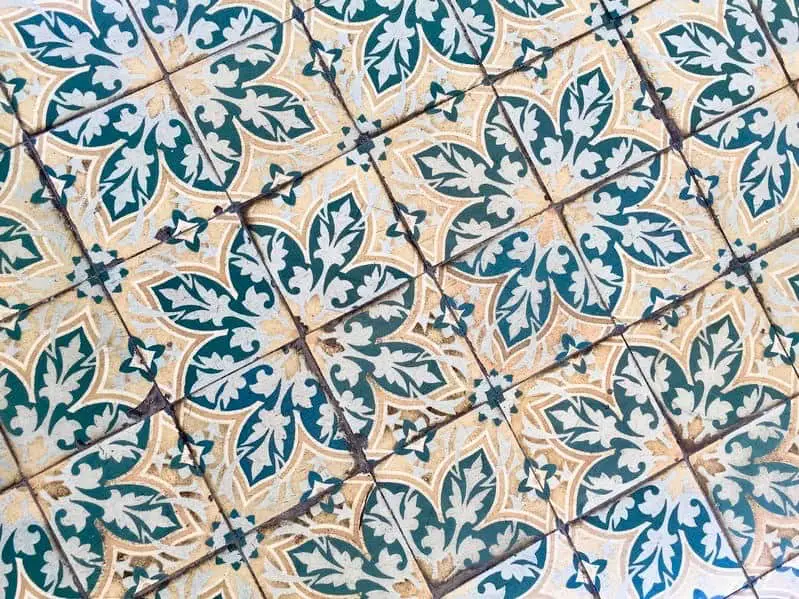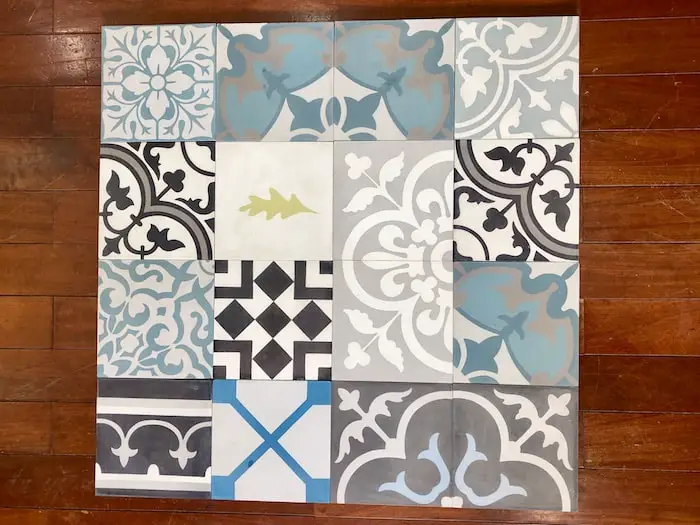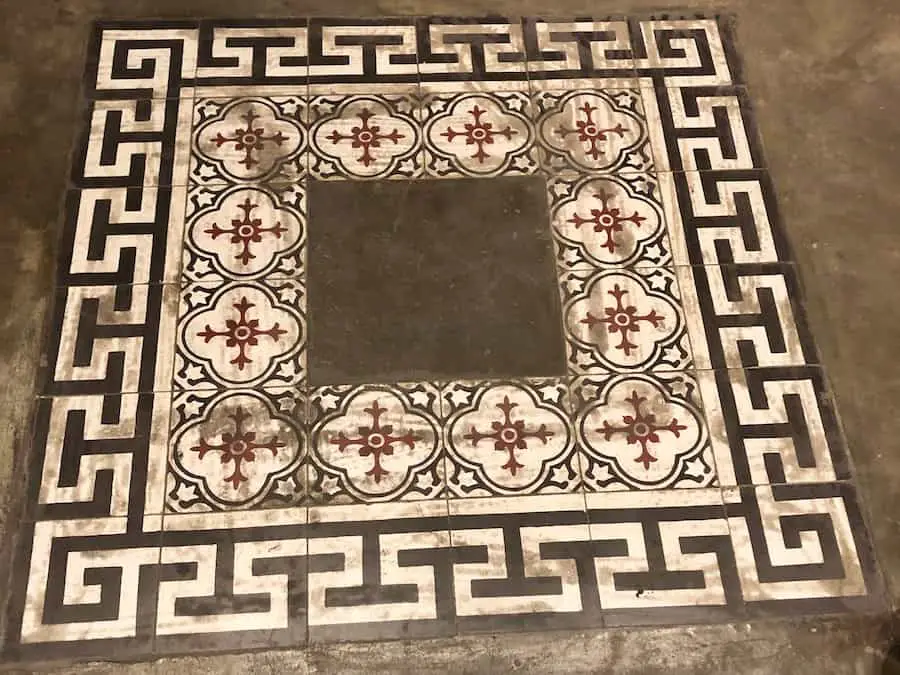Over 25 years ago, I discovered these wonderful old French encaustic cement tiles when I was working in Nha Trang, Vietnam, to produce woven rattan furniture. The minute I saw these French encaustic cement tiles on the floors of many of the Vietnamese buildings, I fell in love with them.
The French encaustic cement tile is a cement tile with a clay design on the top surface of the tile. The design is pressed into a layer, so the cement tiles have two layers, one with the pattern and one bottom layer. The tiles have been manufactured and made throughout the world. The French brought the encaustic cement tiles production to Vietnam in the 1850s. Since then, the Vietnamese have continued to manufacture these encaustic cement tiles, using many of the old French designs and some of their modern designs. The Vietnamese manufacturers export encaustic cement tiles worldwide and use them in many buildings in present-day Vietnam.
Table of Contents
- Definition of French encaustic cement tiles
- The Vietnamese French encaustic cement tile history
- French encaustic cement tiles today
- Caring for French encaustic cement tiles
- Frequently Asked Questions
- Related Content

Definition of French encaustic cement tiles
There can be some confusion about what precisely encaustic tiles are. The best definition for encaustic times is a tile where the pattern is not made by the glaze on top of the tile as on a ceramic tile that is fired, but an encaustic tile is a tile where the pattern is made by clay on the top of the surface of the tile.
The mixed cement clay is pressed on top of the base tile in the pattern and color of the design using a metal mold for the required pattern. Therefore an encaustic tile has two layers a base layer of cement and then a top layer with is usually a marble powder, cement, and pigment color. It is this top layer where the pattern is made for the tile.
The term encaustic cement tiles comes from the word encaustic, which is a form of metal art that was used in metal enameling in a specialized lost wax metal technique. Encaustic tiles are not painted as the encaustic painters painted with hot beeswax, but the tiles essentially have a frame where the clay is inlaid with the colors and design.
History of French encaustic cement tiles
In 1850, the French started to make encaustic tiles with hydraulic presses. At this time, the tiles were thought to be the low-cost and economical option from the ceramic tile that required a firing process by a kiln. They were a sort of revolution for tile production as they were a lower cost than the alternative tiles of the day, yet they were extremely durable.
These encaustic tiles were made from cement and did not require the firing process as their ceramic tile counterpart. This also allowed them to be produced with some very fine detail that could not be produced at the time with the alternative fired ceramic tiles.
As the French and Europeans colonized many parts of the world, they brought with them the making of French Encaustic tiles, which proved to be quite easy to manufacture while being long-lasting.
Add to this, the tiles seem to do quite well in many tropical settings, such as Cuba, Vietnam, India, Mexico, Cambodia, and Morocco. Essentially, they can be found on the floors in many places worldwide.
Local materials define the French encaustic cement product
As the production of these encaustic French tiles spread around the world. Production also started to become more localized according to the types of materials that could be found in each region. Designs also started to get more localized to account for the local taste, colors, or patterns of the tiles.
Since these tiles did not need to be fired in a kiln and could be aired dried using cement, this also meant that they could be produced in many rustic or rural locations that were not able to produce ceramic-fired tiles. This gave the production of these tiles a lot of versatility.
This is one reason that even today, you can find these tiles on the floors, buildings, and houses in many remote places worldwide. This speaks to how important the tiles were to the development of many of these areas.
Also as the tiles could usually be made locally, this allowed for their costs to be lower than imported tiles, allowing the smaller local craftsmen to be able to supply the tiles for their community. People also would not have to wait for an imported supply to come in by sea or another method.

The Vietnamese French encaustic cement tile history
When the French colonized Vietnam, they brought with them the French Encaustic tile production. Even today, the tiles can be found to grace the floors of many buildings. And houses in Vietnam.
One of the new McDonald’s restaurants in Ho Chi Minh City uses French Encaustic tiles on the floor of their new restaurant. The French encaustic tiles have long been a mainstay for Vietnamese decoration and interior design.
It is believed that the French brought the first hydraulic encaustic tile production machines to Vietnam in the 1850s, just soon after the first machines came to be used in France. This means that essentially the machines used in the French encaustic tiles In France were also used in Vietnam soon after the start of their use in France.
So early on, the Vietnamese used French techniques and patterns to make the encaustic tiles in Southeast Asia.
The Vietnamese craftsmen quickly became very skilled in encaustic tile production. They proved themselves to be very highly skilled in working with their hands and making high-quality encaustic tiles.
Part of the reason was that the production of the French encaustic tiles was not very complicated as it just required a hydraulic press, and then the rest of the tiles could be made by hand. Because of the ease of production under French rule in Vietnam, many small producers started to set up small shops to make these handmade encaustic tiles.
Eventually, the production of the encaustic tiles moved out of the smaller producers and into some factories. The first significant factory for encaustic tiles was set up in 1910 by Brossard et Mopin, a Frenchman in Ho Chi Minh. In 1954, when the French left Vietnam, it was taken over by a Vietnamese owner.
The encaustic tile production went through some rough patches in Vietnam’s history. Right after the liberation of Vietnam in 1975, the production of French encaustic tiles started to shrink dramatically. This continued throughout a large part of the 1980s and 1990s.
Part of this could be some of the materials they used were not that easy to find anymore. People who could afford the tiles usually preferred to have the ceramic version Part of this could be that the ceramic tiles had a smooth coat on them that makes them a bit easier to keep clean.
The start of the 21st century saw the rise and revival of French encaustic tile production in Vietnam. The few small producers that were left producing the tiles, were replaced by some more prominent manufacturers who were able to take the skills from the old traditional production methods but use modern technologies to help streamline the production process.
Where in the past they were many small producers making tiles just for their area, now several major manufacturers started to make the tiles for export and local consumption.
One of the beautiful things about Vietnam’s French Encaustic tiles is that you can find these tiles all over Vietnam. Today they are still in many older buildings, but you can also find them being used in a lot of new building construction.
Many Vietnamese consider them to be an essential part of their cultural heritage. This sense of cultural pride has helped to revive this old French tile production.
French encaustic cement tile characteristics
The French Encaustic tiles are essentially two layers. The lower layer is a high-strength cement, while the top layer is a marble powder, white cement, and color pigments. This means that the tile is is very hard-wearing as the design runs through the tile surface, not just on the top surface.
Many French encaustic tile producers in Vietnam still use many of the older French patterns along with many of the new and modern patterns. Many of the designs and colors reveal French history in Vietnam.
In the past, hand hydraulic presses were used, but today many manufacturers have changed to use electric hydraulic presses. The reason is that the electric presses will ensure the tiles are more consistent, and they can press them at a higher pressure (1,500 PSI). The higher pressure allows the color pigment to be pressured more into the base or cement layer.
Understanding the French encaustic cement tile quality
When looking at encaustic tiles there are several things you would look at for the quality of the tiles. Here are some of the things you should consider:
- The sharpness of design – The design on the tile should be sharp, clean, and clear. The clay color should not run between the design or colors have been bleeding.
- Same size between layers – The top and bottom layers should be the same size. Sometimes, as two colors are being used, if the quality of the tile is not very good, the top and bottom layers can be a different size due to the different shrinkage of the two layers. In a good-quality tile, the top and bottom layers would be exactly the same size.
- The hardness of the colored layer – The top layer must be very hard and not soft. This is very important especially if It is to be used on a surface like a floor.
- The thickness of the colored layer – The thickness of the upper colored clay layer should be about 2.5 to 3 mm thick or thicker, especially if the tiles are to be used as a floor covering.

French encaustic cement tiles today
Today, some of the local Vietnamese encaustic factories are willing to make or reproduce your tile design in the colors and designs that you want. The reason is that actually producing these tiles and setting up a new design is not very complicated.
This means it would be possible if someone wanted to use these tiles on a product or as a decorative element on a product. There are some minimums that are required for each tile design, and the minimums can depend on the design itself, the number of colors for the designs, and the complication of the design items.
Generally speaking, encaustic tiles can have up to six colors on one tile. Many of the tiles have two colors or four colors. Of course, the more colors, the more complicated the production can be.
Caring for French encaustic cement tiles
French encaustic tiles are highly absorbent, requiring special care and protection. As the tile has two layers, it can be sensitive to acid or many of the newer cleaning products, which can be harsh and damage the tile.
You should try to use a mild or less harsh soap. Do not use any acids, white spirit solvents, or ammonia, as this could destroy the top surface of the tiles.
A recommended brand for cleaning the tiles is FilaPS87. This cleaner is made for cement floors, so it will not damage the surface of your encaustic tiles. You can find more information on the Fila PS 87 cleaner by clicking here.
You can put a sealer on the floor to help seal your encaustic tiles against stains and other spills. You can put the sealer on with a paintbrush, then dry and wipe off the excess. A very good sealer to use is also a Fila product.
You can use a product called Fila FOB sealer, you can find out more about it by clicking here. Or you can also use another Fila product called Fila MP 90 Concrete sealer you can find out more about it by clicking here.
You can also put a protective coating on the French encaustic tiles by applying a protective coating like wax on them. This is similar to how you would apply some wax to a wood floor.
For a more satin finish, you can use the Fila Stain Wax or for more of a shine use the Fila Classic or Glossy Wax. You can find out more about the Fila Stain Wax by clicking here. For the Fila Classic or Glossy wax, which gives you more of a shine, you can find out more about it by clicking here.
French encaustic tiles are truly a beautiful and historic work of art. It is a technique that has lasted since the 1850s and has continued today. In many parts of the world, including Vietnam, the French encaustic cement tiles have become part of the country’s cultural heritage.
The French encaustic tiles are not only beautiful on the floors and walls, but they are also can be used for some wonderful home decor product inspiration.
Find out more about how Mondoro can help you create, develop, and manufacture excellent home decor and furniture products – don’t hesitate to contact me, Anita. Check out my email by clicking here or become a part of our community and join our newsletter by clicking here.
Mondoro gives out a FREE Lookbook to anyone interested. You can receive a copy of our latest Lookbook by clicking here.
Listen to our Podcast called Global Trade Gal. You can find it on all major podcast platforms. Try out listening to one of our podcasts by clicking here.
Subscribe to our Mondoro Company Limited YouTube Channel with great videos and information by clicking here.
Frequently Asked Questions
Are cement or encaustic cement tiles durable?
With proper care, cement or encaustic tiles are extremely durable. This has been proven many times in places like Vietnam, which still have the original encaustic tiles on the floor of buildings, even buildings that are in public spaces. These French encaustic tiles’ durability will outlive us all.
Is an encaustic cement tile slippery when wet?
Like any other cement ceramic or marble floors, French encaustic tiles can also be slippery when wet. As they absorb water, it is best if you can put a sealer on the encaustic cement tiles and also a wax coating to help protect them. You can read our section above about caring for your French encaustic cement tiles.
What are French Encaustic Tiles?
French Encaustic Tiles are a type of decorative tile traditionally made using different colors of clay. The patterns are not glazed on but inlaid, making them distinct and durable. They are known for their beautiful, intricate designs and have been used historically in various buildings across France.
How are French Encaustic Tiles made?
These tiles are crafted by pressing different colors of clay into a pattern using a mold. The tiles are then fired to harden them. This method ensures that the design runs deep into the tile, rather than just sitting on the surface.
What makes French Encaustic Tiles unique?
Their unique quality lies in their inlaid patterns, which are created with colored clay rather than being painted or glazed. This technique gives the tiles a distinctive depth and richness of color that does not fade over time.
Can French Encaustic Tiles be used on floors and walls?
Yes, these tiles are versatile and can be used for both floor and wall applications. Their durability makes them suitable for high-traffic areas.
Are French Encaustic Tiles durable?
Yes, they are extremely durable. The inlaid pattern means that the design remains intact even as the tile wears down, making them ideal for places that see a lot of foot traffic.
Are French Encaustic tiles suitable for outdoor use?
While French Encaustic Tiles can be used outdoors, they should be sealed properly to protect against weather elements. It’s important to consult with a tile expert about the best practices for outdoor installation.
Can these tiles be customized?
Customization options vary depending on the manufacturer, but generally, there is some flexibility in choosing colors and patterns to suit individual preferences.
What is the price range for French Encaustic Tiles?
The price can vary widely depending on the complexity of the design and the manufacturer. Generally, they are considered a premium tile product due to their unique manufacturing process and durability.
Related Content
What Is Interior Design?
Interior design is a creative field that requires an understanding of the interior, architecture, decoration, products, design, and art. An interior designer must understand all the colors, materials, textures, furniture, lighting, and anything that will go into the interior space. They must also be able to work with their clients and be able to work within an assigned budget.
You can discover more by reading What Is Interior Design? by clicking here.
Minimalist Interior Design Explored: Embracing The Trend
Interior design, like fashion, is cyclic, swinging between extremes: lavish extravagance and understated simplicity. Of late, Minimalist Interior Design has gained traction, appealing to those who appreciate a clean, streamlined aesthetic.
By clicking here, you can learn more by reading Minimalist Interior Design Explored: Embracing The Trend.
What Is The Coastal Interior Design Style?
The Coastal Interior Design style combines coastal and traditional design into one design trend. The coastal interior design style is a tranquil and soothing trend that remains popular today. Even though the technique is used in many houses near a beach or lake, it continues to be a popular look and interior design that can be used anywhere.
You can learn more by reading our blog What Is The Coastal Interior Design Style? by clicking here.


